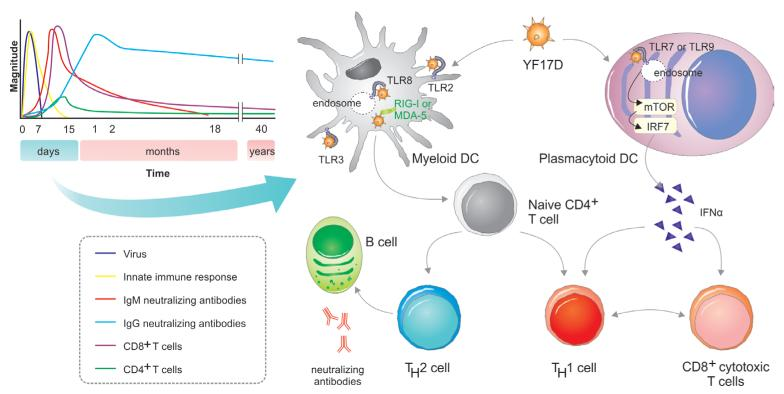Immunity to viruses: learning from successful human vaccines.
For more than a century, immunologists and vaccinologists have existed in parallel universes. Immunologists have for long reveled in using 'model antigens', such as chicken egg ovalbumin or nitrophenyl haptens, to study immune responses in model organisms such as mice. Such studies have yielded many seminal insights about the mechanisms of immune regulation, but their relevance to humans has been questioned. In another universe, vaccinologists have relied on human clinical trials to assess vaccine efficacy, but have done little to take advantage of such trials for studying the nature of immune responses to vaccination. The human model provides a nexus between these two universes, and recent studies have begun to use this model to study the molecular profile of innate and adaptive responses to vaccination. Such 'systems vaccinology' studies are beginning to provide mechanistic insights about innate and adaptive immunity in humans. Here, we present an overview of such studies, with particular examples from studies with the yellow fever and the seasonal influenza vaccines. Vaccination with the yellow fever vaccine causes a systemic acute viral infection and thus provides an attractive model to study innate and adaptive responses to a primary viral challenge. Vaccination with the live attenuated influenza vaccine causes a localized acute viral infection in mucosal tissues and induces a recall response, since most vaccinees have had prior exposure to influenza, and thus provides a unique opportunity to study innate and antigen-specific memory responses in mucosal tissues and in the blood. Vaccination with the inactivated influenza vaccine offers a model to study immune responses to an inactivated immunogen. Studies with these and other vaccines are beginning to reunite the estranged fields of immunology and vaccinology, yielding unexpected insights about mechanisms of viral immunity. Vaccines that have been proven to be of immense benefit in saving lives offer us a new fringe benefit: lessons in viral immunology.
Authors
Bali Pulendran; Jason Z Oh; Helder I Nakaya; Rajesh Ravindran; Dmitri A Kazmin
External link
Publication Year
Publication Journal
Associeted Project
Systems Vaccinology
Lista de serviços
-
Genomic analyses reveal broad impact of miR-137 on genes associated with malignant transformation and neuronal differentiation in glioblastoma cells.Genomic analyses reveal broad impact of miR-137 on genes associated with malignant transformation and neuronal differentiation in glioblastoma cells.
-
RNA-Binding Protein Musashi1 Is a Central Regulator of Adhesion Pathways in Glioblastoma.RNA-Binding Protein Musashi1 Is a Central Regulator of Adhesion Pathways in Glioblastoma.
-
MicroRNA Transcriptome Profiling in Heart of Trypanosoma cruzi-Infected Mice: Parasitological and Cardiological Outcomes.MicroRNA Transcriptome Profiling in Heart of Trypanosoma cruzi-Infected Mice: Parasitological and Cardiological Outcomes.
-
Genome mapping and expression analyses of human intronic noncoding RNAs reveal tissue-specific patterns and enrichment in genes related to regulation of transcription.Genome mapping and expression analyses of human intronic noncoding RNAs reveal tissue-specific patterns and enrichment in genes related to regulation of transcription.
-
Antimicrobial peptide LL-37 participates in the transcriptional regulation of melanoma cells.Antimicrobial peptide LL-37 participates in the transcriptional regulation of melanoma cells.
-
Down-regulation of 14q32-encoded miRNAs and tumor suppressor role for miR-654-3p in papillary thyroid cancer.Down-regulation of 14q32-encoded miRNAs and tumor suppressor role for miR-654-3p in papillary thyroid cancer.
-
Integration of miRNA and gene expression profiles suggest a role for miRNAs in the pathobiological processes of acute Trypanosoma cruzi infection.Integration of miRNA and gene expression profiles suggest a role for miRNAs in the pathobiological processes of acute Trypanosoma cruzi infection.
-
Integrative Biology Approaches Applied to Human DiseasesIntegrative Biology Approaches Applied to Human Diseases
-
Proteomics reveals disturbances in the immune response and energy metabolism of monocytes from patients with septic shock.Proteomics reveals disturbances in the immune response and energy metabolism of monocytes from patients with septic shock.
-
Genomics, epigenomics and pharmacogenomics of Familial Hypercholesterolemia (FHBGEP): A study protocol.Genomics, epigenomics and pharmacogenomics of Familial Hypercholesterolemia (FHBGEP): A study protocol.
-
Melatonin-Index as a biomarker for predicting the distribution of presymptomatic and asymptomatic SARS-CoV-2 carriersMelatonin-Index as a biomarker for predicting the distribution of presymptomatic and asymptomatic SARS-CoV-2 carriers
-
Profiling plasma-extracellular vesicle proteins and microRNAs in diabetes onset in middle-aged male participants in the ELSA-Brasil study.Profiling plasma-extracellular vesicle proteins and microRNAs in diabetes onset in middle-aged male participants in the ELSA-Brasil study.
-
Big Data and machine learning in cancer theranosticsBig Data and machine learning in cancer theranostics
-
Genomic positional conservation identifies topological anchor point RNAs linked to developmental loci.Genomic positional conservation identifies topological anchor point RNAs linked to developmental loci.
-
Integrative systems immunology uncovers molecular networks of the cell cycle that stratify COVID-19 severityIntegrative systems immunology uncovers molecular networks of the cell cycle that stratify COVID-19 severity

